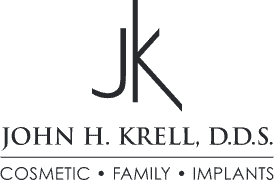- Heal Your Smile With Gum Disease Treatment
- Scaling & Root Planing
- Soft Tissue Laser
- Antibiotic Therapy
- Is Gum Disease Reversible?
- Symptoms of Periodontal Disease

Heal Your Smile With Gum Disease Treatment
The title to this page is true—the most common dental issue in the entire world is periodontal disease, more commonly known as gum disease. Many people are completely unaware that they have it, and this is because it starts with very subtle symptoms. Over time, however, it can develop into a serious dental and overall health problem. Dr. John Krell and his team will always keep an eye on the state of your gums when you come in for a regular checkup. That way, we can catch the disease as early as possible and treat it quickly.
Scaling & Root Planing
These two procedures provide a deep cleaning for your gums, and they are one of the main ways we treat advanced gum disease.
Scaling uses specialized tools to clear away plaque and bacteria that has gathered along and under your gum line. Then, root planing will be used to gently smooth out the roots of your teeth. This will make it much harder for plaque to build up on your gums in the future. Typically, these treatments can be completed in just one or two appointments.
Soft Tissue Laser
Thanks to modern technology, we can treat your gum disease faster and easier than ever. Using the Odyssey soft tissue laser, we can precisely remove plaque, bacteria, and even diseased tissue while causing you little to no pain. The laser itself is so accurate that it won’t affect any of the surrounding gum tissue that doesn’t need to be treated, meaning you’ll have a much easier recovery time afterward as well.
Antibiotic Therapy
To help fight your gum disease while you are at home, your doctor may choose to use antibiotic therapy. For this, they’ll apply a powdery substance called Arestin directly to any infected tissue. This powder is actually composed of thousands of microspheres that are filled with a powerful medicine, and they will slowly dissolve over time. This will help your treatment last for a longer time and assure your gums are free of harmful bacteria.
Is Gum Disease Reversible?
Gum disease is progressive, and bone loss does not occur until its more advanced stages. Because of this, early-stage gum disease can be reversed with proper care. If you notice that your gums are reddish, or slightly puffy, but have not started to pull away from the teeth yet, you may be experiencing the initial stage of gum disease, also known as gingivitis. This can be treated by improving your oral health routine. Even if you are brushing and flossing daily, incorrect techniques can make it difficult for you to remove all plaque from the gumline, which is a catalyst for gum disease. Depending on your case, you may want to consider using an oral irrigator, also known as a water flosser, to enhance your daily plaque removal efforts. While it should never be used as a brushing and flossing replacement, oral irrigators can boost the health of your gums and keep harmful bacteria at bay.
Symptoms of Periodontal Disease
Many patients experience symptoms of periodontal disease without realizing the cause. For example, bleeding gums are often thought to be the result of brushing too rigorously. While improper brushing can indeed irritate the gums, gum bleeding is also a sign that you have gum disease. Other symptoms may include:
- Gums that appear red or purple
- Inflamed, swollen gums
- Sensitivity
- Gum soreness
- Bad breath that does not improve with regular brushing and flossing
- Pain while chewing
- Gums that have begun to pull away from the teeth
- Teeth that feel loose




